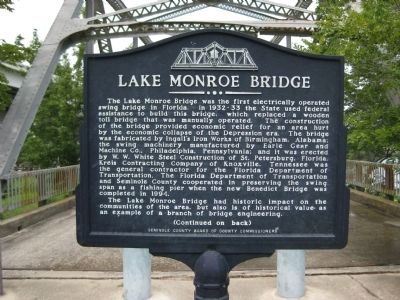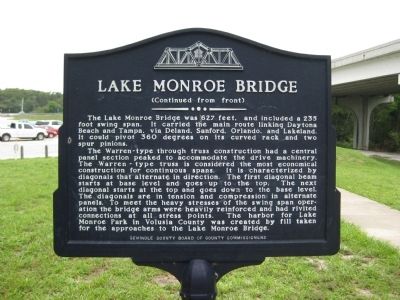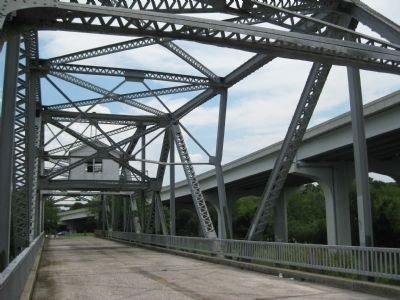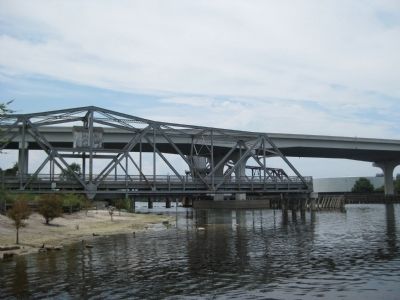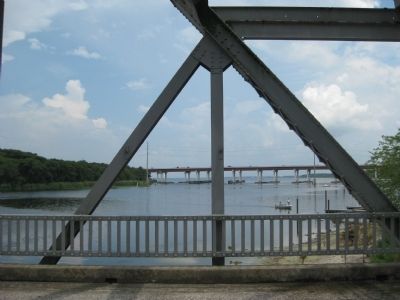Near Sanford in Seminole County, Florida — The American South (South Atlantic)
Lake Monroe Bridge
The Lake Monroe Bridge was the first electrically operated swing bridge in Florida. In 1932-33 the State used federal assistance to build this bridge, which replaced a wooden toll bridge that was manually operated. The construction of the bridge provided economic relief for an area hurt by the economic collapse of the Depression era. The bridge was fabricated by Ingall's Iron Works of Birmingham, Alabama; the swing machinery manufactured by Earle Gear and Machine Co., Philadelphia, Pennsylvania; and it was erected by W. W. White Steel Construction of St. Petersburg, Florida. Kreis Contracting Company of Knoxville, Tennessee was the general contractor for the Florida Department of Transportation. The Florida Department of Transportation and Seminole County cooperated in preserving the swing span as a fishing pier when the new Benedict Bridge was completed in 1994.
Reverse:
The Lake Monroe Bridge had historic impact on the communities of the area, but also is of historical value as an example of a branch of bridge engineering.
The Lake Monroe Bridge was 627 feet, and included a 235 foot swing span. It carried the main route linking Daytona Beach and Tampa, via Deland, Sanford, Orlando, and Lakeland. It could pivot 360 degrees on its curved rack and two spur pinions.
The Warren-type through truss construction had a central panel section peaked to accommodate the drive machinery. The Warren-type truss is considered the most economical construction for continuous spans. It is characterized by diagonals that alternate in direction. The first diagonal beam starts at the base level and goes up to the top. The next diagonal starts at the top and goes down to the base level. The diagonals are in tension and compression in alternate panels. To meet the heavy stresses of the swing span operation, the bridge arms were heavily reinforced and had rivited connections at all stress points. The harbor for Lake Monroe Park in Volusia County was created by fill taken for the approaches to the Lake Monroe Bridge.
Erected by the Seminole County Board of County Commissioners.
Topics. This historical marker is listed in these topic lists: Bridges & Viaducts • Industry & Commerce • Roads & Vehicles. A significant historical year for this entry is 1994.
Location. 28° 50.199′ N, 81° 19.453′ W. Marker is near Sanford, Florida, in Seminole County. Marker is on West Seminole Boulevard (U.S. 17/92) north of Interstate 4. The marker is located near where the Lake Monroe flows into the St. Johns River, on the grounds of Lake Monroe Wayside Park, a Seminole County park, at the entrance to the remaining span of the old bridge. Touch for map. Marker is at or near this postal address: 4150 Northwest US Highway 17/92, Sanford FL 32771, United States of America. Touch for directions.
Other nearby markers. At least 8 other markers are within 3 miles of this marker, measured as the crow flies. Woodland Park (approx. 0.8 miles away); Bookertown (approx. 0.9 miles away); POW / MIA’s Memorial (approx. 2.3 miles away); Korean War Veterans Memorial (approx. 2.3 miles away); F-15 Aircraft (approx. 2.3 miles away); Charles Richard Beall (approx. 2.4 miles away); Martin Luther King Jr. (approx. 2.4 miles away); Upsala Swedish Community (approx. 2.9 miles away). Touch for a list and map of all markers in Sanford.
More about this marker. The marker has a front and back side, with the inscription beginning on the front and continuing to the back. It is capped with a diagram of the bridge.
Regarding Lake Monroe Bridge. The Seminole County side of the old bridge is still standing and is accessible to park visitors. Across the St. Johns River, in Volusia County, the old bridge was removed.
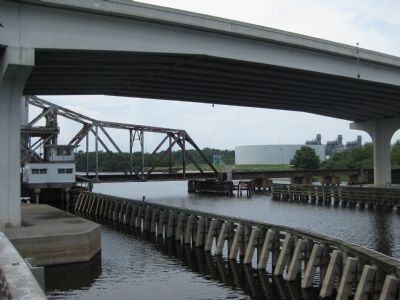
Photographed By AGS Media, August 1, 2011
8. View north from the end of the old bridge
Credits. This page was last revised on July 12, 2018. It was originally submitted on August 3, 2011, by Glenn Sheffield of Tampa, Florida. This page has been viewed 1,662 times since then and 120 times this year. Photos: 1, 2, 3, 4, 5, 6, 7, 8. submitted on August 3, 2011, by Glenn Sheffield of Tampa, Florida. • Bill Pfingsten was the editor who published this page.
